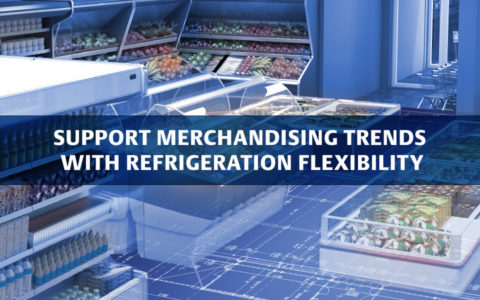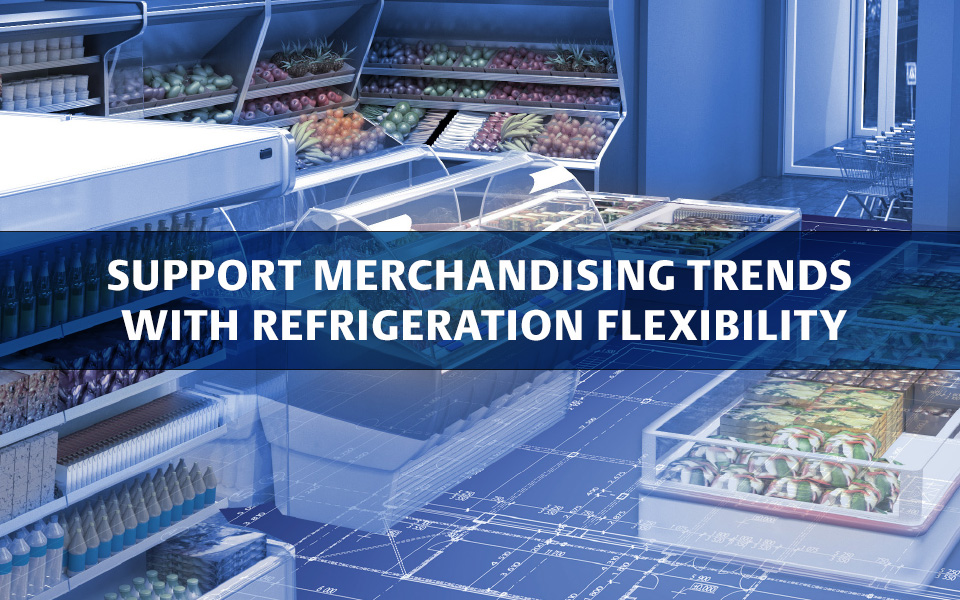Simplify refrigeration merchandising strategies

*On June 1, 2023 Emerson’s Climate Technologies business became a new standalone company – Copeland. Though our name has changed, we are building on more than a century of HVACR innovation and industry leadership, and Copeland continues to offer the same products, industry stewardship, and learning opportunities you’ve grown to trust. Information found on this webpage posted before June 1, 2023 may contain our old name or branding, but you can be at ease knowing it was created with the knowledge and expertise of Copeland.
Dynamic food retail market trends continue to reshape the physical layouts of grocery stores. In the never-ending quest to keep consumers engaged, retailers are rotating display cases, placing featured items in high-visibility areas, and/or redirecting shopping flows. At the same time, shrinking store footprints are forcing operators to explore distributed refrigeration architectures. In a recent E360 article, we explored how flexible refrigeration strategies are helping retailers adapt to modern food retail merchandising challenges.

In traditional store layouts, product has historically been categorized into relatively fixed aisles and locations. But as retailers try to tailor store environments to consumers’ shopping preferences, these fixed aisles are being more frequently supplemented by a steady rotation of seasonal produce and specialty items.
As the trend toward urbanization drives more retailers to open smaller stores in existing metropolitan facilities, operators simply don’t have the space to support centralized direct expansion (DX) refrigeration. And while larger stores still rely on these DX refrigeration systems, many are starting the process of decommissioning portions of their systems for a variety of reasons:
– Ensure reliable refrigeration performance
– Comply with environmental regulations
– Hit corporate sustainability targets
These dynamic factors are combining to significantly impact refrigeration equipment architectures.
Shifting to distributed strategies
Enabling merchandising and architectural flexibility requires making the shift from centralized DX systems toward one of many available distributed architectures. Distributed simply refers to the practice of distributing refrigeration condensing units (CUs) throughout a store to support various case loads. This can be achieved by integrating the CU into the refrigeration case itself, or by placing it within close range of cases.
Let’s look at a few of the leading distributed refrigeration options in the food retail space.
Micro-distributed (self-contained) — For retailers seeking maximum merchandising flexibility, plug-and-play, self-contained cases can be repositioned throughout a retail store. To meet applicable safety standards, units are currently factory-charged with up to 150g of R-290. However, a recent update to the UL 60335-2-89 safety standard has set the stage for R-290 charge increases depending on whether the unit has an open- or closed-door design:
– 500g for open appliances without doors or drawers
– 300g for closed appliances with doors or drawers
Although additional regulatory approvals and appropriate safety considerations will be needed to implement these higher charges, the potential for larger capacity self-contained R-290 units is now on the horizon. Multiple units can be placed on a shared water loop to remove condenser heat from a store. However, this scalable approach may limit mobility due to piping and installation requirements.
Outdoor condensing units (OCUs) — Recent advancements in modern technology have expanded OCU flexibility. Rather than using a fixed-capacity compressor — which provides a one-to-one relationship between a CU and a refrigeration fixture — digital compressors can now enable variable-capacity modulation and the ability for one OCU to support multiple fixtures.
The Copeland™ digital outdoor refrigeration unit, X-Line Series, continually modulates its capacity to precisely match the refrigeration loads of multiple fixtures. Instead of one fixed CU running at 100 percent capacity, regardless of demand, the digital X-Line delivers scalability from one to multiple units with just one OCU. Variable-capacity modulation advantages include:
– More precise temperatures
– Effective load matching
– Improved energy efficiencies
Distributed scroll booster — Well-suited for new stores, retrofits and replacements, the Copeland scroll booster offers a unique balance of simplicity, sustainability and flexibility. By utilizing a low-pressure, zero glide A1 refrigerant (R-513A) for both low-temperature (LT) and medium-temperature (MT) circuits, this system is designed to:
– Offer a familiar servicing profile
– Scale from one to multiple refrigerated display cases or freezers
– Eliminate the high discharge temperatures and compression ratios typically found in LT systems
The Copeland scroll booster enables the use of systems with smaller refrigerant charges and lower-GWP refrigerants (R-513A = 573 GWP), while delivering improved energy efficiencies and high reliability.
The Copeland indoor modular solution — This plug-and-play refrigeration package is designed to support larger self-contained cases by integrating all key system components within the unit itself:
– Low-profile, Copeland horizontal variable speed scroll compressor maximizes case merchandising space and delivers superior energy efficiencies.
– Integrated refrigeration circuit simplifies system design and architecture.
– Electronic controls provide seamless supervisory control platform integration.
In addition, the Copeland indoor modular solution can enable a distributed refrigeration system to scale from one to multiple units — with multiple cases connected to a shared water loop.
To learn more about Emerson’s solutions for flexible and sustainable distributed refrigeration solutions, please visit our website.

8 proven strategies for rigorous cold chain management
by Dan Knauer | Cold Chain
Preparing for the approval and safe use of A2Ls in commercial refrigeration applications...
Protection for high-value shipments just got even better
by Alex Axelsson | Cold Chain, Transportation
We’re excited to announce the release of Copeland’s newest real-time tracker, the GO Real-Time...

Three proven strategies to prevent cargo theft
by Chris Lafferty | Cold Chain, Transportation
The over-the-road (OTR) transport industry is experiencing a surge in cargo thefts. As thieves...
The post Simplify Refrigeration Merchandising Strategies appeared first on Copeland.